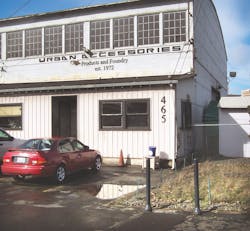Located in Tacoma, Wash., the Urban Accessories foundry was a small family-operated facility sitting on 1.7 acres. Despite its best efforts to reduce copper in its storm water, the operational and structural BMPs they had implemented had not met the required benchmark of 14 µg/L. As a result, the Washington Department of Ecology demanded some form of treatment that would comply with the storm water permit. Ecology suggested a small package plant with a capital cost of between $60,000 and $100,000, but as a small business, Urban Accessories could not afford the capital cost nor the continual operation and maintenance costs of a small active treatment system.
The company needed a less expensive and lower maintenance passive treatment method it could afford and easily operate and maintain. It landed on a material that looked like a promising solution: peat sorption media.
Peat Sorption Media
Peat is a natural material and has long been known for its ability to remove metals from water. Natural peat, though relatively inexpensive, tends to be non-uniform, is somewhat difficult to handle and has poor flow properties. Typically, raw peat has a hydraulic conductivity two to three orders of magnitude lower than coarse sand. These lower conductivities reduce the overall flow rate, increase the potential for channelization and make deployment as a treatment media difficult.
American Peat Technology (APT), a peat harvester in central Minnesota, developed a granulation and low temperature hardening process to convert raw peat into an engineered sorption media.
The granular media maintain its structure when wet and can be produced in a variety of sizes to meet the specifications of individual projects. This scalability lets it adapt to a variety of treatment systems. The granule size is 0.6 to 2 mm, and has an estimated hydraulic conductivity around 0.5 cm per second, both of which are comparable to coarse sand. Despite the processing conditions, the media retains nearly all the metal removal capacity of the raw peat. Total metal removal is a function of solution chemistry. Maximum capacities achieved in laboratory equilibrium tests range from 1% to 15% dry weight.
Since all of the storm water from the Urban Accessories site flowed to a single drain system, the company chose a flow-through treatment process using peat sorption media in homemade filter socks. The media was placed in nylon stockings, which were then placed in the drain line. The media swells slightly when wetted, so when they came in contact with the storm water, the stockings expanded, filled the drain and forced the site’s storm water to flow through the media prior to discharge.
Copper Cutback
After the peat sorption filter socks were installed, copper concentrations dropped below the benchmark value. The site has been in compliance ever since. Peat sorption media has a significant capacity for copper. Urban Accessories replaces the socks every three months even though there is still removal capacity remaining in the filter stockings. However, since it can treat all its storm water for less than $200 per year, the small additional cost for more frequent media replacement is not an issue. In addition, if it can demonstrate continual compliance, the company can suspend monitoring for predetermined periods, which more than save the additional cost of more frequent media replacement.
Meeting Long-Term Goals
After demonstrating continual compliance, the company was not required to monitor for three years. After that three-year period, monitoring again was required to show that the site still was in compliance. Currently, if the site remains in compliance for an additional two years, monitoring will once again be suspended for three years.
The use of the peat sorption media not only brought the Urban Accessories site into compliance, but the low capital and operating costs prevented serious financial problems. It has been satisfied with the performance of the media.

